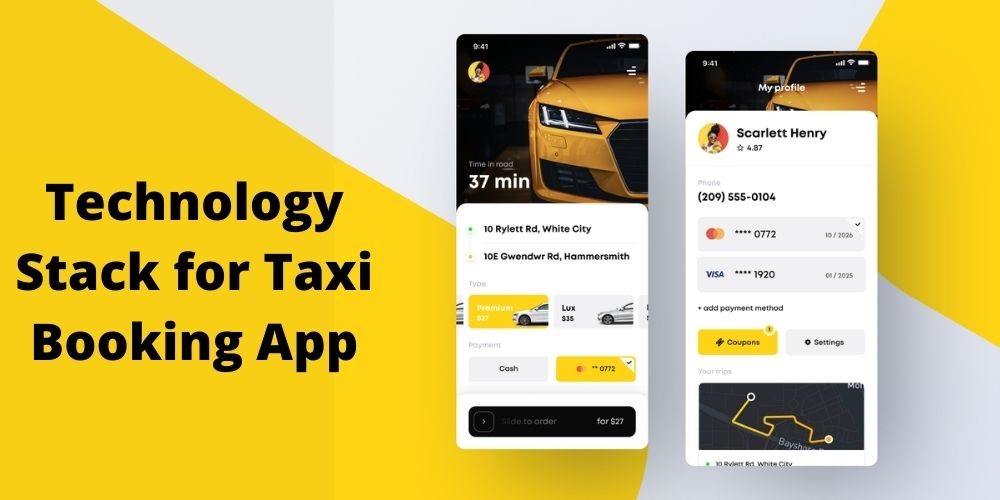Well, when it comes to the On-Demand Taxi Booking app, our mind gets flooded with the names of top Cab-Booking apps, like Uber, Ola, and more. Without powerful mobile applications, these in-demand apps would haven’t caught up with this success.
With the growing Cab-Booking services, the demand for the Taxi Booking mobile app development service is also expanding. That’s why to offer a unique and best-fit On-demand Taxi service, you need to incorporate necessary technologies, accessibility, infrastructure, and resources in your mobile app.
That’s why it’s essential to choose the right technology stack for developing a Taxi Booking App. Today, we have come up with the technology stack that should be incorporated while developing a taxi booking app. So, let’s start with the same.
What To Consider For Finding The Right Technology Stack for A Taxi-Booking App
- Geo-Location & Mapping
- Push Notifications
- Inter-App Communication or Logging
- Payment
- Payment Gateway
- Infrastructure and Storage
- App Provisioning
- Routing and Service Discovery
- Development and Deploy
- Testing
- Reliability
- Web
- Languages
- Web Server
- Mobile
- iOS
- Seeing and Using Data
Geo-Location & Mapping
If we want our on-demand taxi booking app to perform properly, we should strengthen its roots including its fundamental requirement, the location services. The app should hold the potential to pick your current location and allow you to share it as your pick-up location with your allocated driver to facilitate the passenger to know the real-time locale of the driver on a map. Obviously, On-Demand services ask for location technology to perform as desired.
Push Notifications
An On-Demand Taxi app sends notifications to the driver, passenger through various mediums, like SMS, push notification services, and email.
Along with push notifications, text notifications are required as the former one doesn’t work at all if while undergoing operation, the device may go offline. In fact, as we talk about the Apple Push Notification Service, it makes a queue of the notifications the device receives when it goes offline, but when it comes online, the notifications stay undelivered.
The Developer has no option to know the status of the notifications, if it’s delivered or not. This doesn’t happen with Google Notification.
Notifications that on-demand taxi apps receive are:
- Driver: Accept or decline ride
- Rider: Ride accepted/canceled
- Rider: Ride Arrival
- Rider: Surge Pricing Over
- Rider: Fare Updated
Inter-App Communication or Logging
In the On-Demand Taxi booking solution, the app of the driver and rider demands communication with each other in various cases, the absence of which may lead to a total collapse of the entire solution. The major part of the communication is carried on the cloud and a passenger is allowed to book a taxi even if his device goes offline post-booking.
On the other end, the driver should stay online every time as the passenger app needs to track the live spot of an interactive app on the application and immediate location is shared over Wi-Fi or data connection.
The app holds a data traveling protocol that decides the communication flow. This may be encrypted or not depending on the choice of the provider. The app server routes the data to the destination end. The data quality relies on the resources of the data exchange supporting the system backing it.
These two apps (drivers’ and passengers’) communicate in different ways with each other as below:
- Send/accept booking request
- Current location detection
- Direction tracking
- Ride/Fare calculations
- Chat and messaging
- Ride rating and review
- Cancel request – both ways
- For logging: Apache Kafka cluster
- For searching and visualizations: Elasticsearch, Logstash, and Kibana
Payment Processing
For On-Demand Cab service applications, payment is the most imperative part. Moreover, chiefly it depends on the cashless payment system that is sourced through a payment gateway. Today, such services have also started including cash payment options where the cashless payments are still developing. A feature, split-fare offered by Braintree & Stripe has also become a standard feature across the taxi booking apps, which facilitates automatic fare splitting offering relaxation to your mind.
Payment Gateway
In the mobile payment market, Braintree is realized as a leader of all that accepts card payments. A competitor of this leading mobile payment market and a great payment system, Stripe is picked in custom taxi app development services. Stripe offers its perfect payment services to various on-demand, fast-moving economy startups.
In Stripe and Braintree, the split fare option is available by default.
Infrastructure and Storage
To coordinate and communicate better with back-end services, for the infrastructure and storage solution, we need to include an entire range of processing entities and functional factors providing a comprehensive ecosystem of the infrastructure and the storage resources that are provided by an exclusive facility of Virtual Machines Caching & Queuing, App Provisioning, and Languages, Routing & Service Discovery, among the others.
- For hybrid cloud model: Terraform
- For distributed storage and analytics for complex data: Hadoop
- For both caching and queuing: Redis with Twemproxy & Celery workers
- Other: PostgreSQL, Riak, Cassandra, Hive, MapReduce, HDFS, Elasticsearch
App Provisioning
When user identities and roles get created in the cloud apps, to which the users need access is app provisioning. You should consider a software platform to run the microservices scalably with constant configurations along with the assistance of a framework for cron jobs and long-running services.
For App provisioning: Docker, Mesos, Aurora
Routing and Service Discovery
For the success of an On-Demand Cab service, a service-oriented architecture is used that makes the service discoverable and routing. Also, service should hold the potential to communicate with each other even in complex networks.
- HAProxy
- For front-end web server: NGINX
- For interface definition languages: Thrift and Protobuf
Development and Deploy
A collection of open source web apps strengthens various internal operations, starting from code review to documentation to process automation. Well, mobile development is completely trunk development and train releases. You should try something to keep your software versions over time. But, most engineers developing the apps commit to master directly. So various people branching and the landing appears with many risks. So, the mobile app service provider should use an in-house service and app configuration platform that is simple to use and develop on top of, allowing stakeholders to catch-up with the change in the On-demand cab businesses and services.
To handle builds, the app providers should develop an internal deployment system. Despite performing a QA process manually, the Taxi Booking App solution provider should invest the most in monitoring and automating. In fact, the continuous integration and the enforcement constantly scales faster, and the monitoring allows auto-responsive systems to locate and resolve any flawed commits.
The Taxi-booking apps service providers should be able to develop and handle stable communication channels for the success of their services.
- Phabricator, OpenGrok, Jenkins
- For building, managing, and developing on virtual machines: Packer, Vagrant, Boto, and Unison
- For inventory management: Clusto
- For managing system configuration: Puppet
- For documentation: Sphinx
- Programming Languages: Go, Java, C, C++, Python, and Node.
Testing
Before the On-demand Taxi apps reach the users, we should keep a check over the new development by performing tests constantly. An app feedback reporter catches the bugs before the app is rolled out.
Reliability
With a target to be available at the best and to handle 1bn rides every day, the engineers should be available with the services that lead to the success of on-demand cab service apps.
- For alerting for monitoring: Nagios
Web
Well, the on-demand cab booking app developers share various common elements, but most technologies are unique also. They develop the apps using the frameworks and libraries to come up with a useful and efficient application. The teams of web and product perform together to build and promote separately-deployed, modular web apps along with the unified user experience and shared user interface.
Languages
The languages are the building blocks of successfully-running taxi-booking apps. Such languages are the big reasons for the high performance. On the other end, such languages demand first-class support also to offer simplicity, efficiency, and better runtime speed.
- Node.js
- For bundling: Browserify
Web Server
The web server should be built above all the well-recognized web frameworks to offer internationalization, security, and other particular pieces that control infrastructure integration.
- Express.js
Mobile
The mobile engineering teams develop successful taxi booking apps prioritizing accessibility and user experience. The teams having seasoned members handles everything from back-end to design and data science.
Languages
- For iOS: Objective C and Swift
- For Android: Java
- For networking: OkHttp, Retrofit, and Gson
iOS
The iOS code is stored in the repository along with Auto Layout that assists with the component sizing and placement. For detecting the crash, a crash reporter is used with the internal reporting framework.
Seeing and Using Data
The On-Demand Taxi app providers offer the app’s data a useful visualization that assists the team to understand it perfectly. For web front-end apps, JavaScript is used. For the back-end, Node.js server can be used. The team uses a stream of homegrown solutions, databases, and open external technologies for streaming, machine learning, querying, and graph processing.
The file storage web services help a lot in storing purposeful data and performing operations.
- For crunching data streams: Storm and Spark
- Web standards for graphics & visualization components: SVG, Canvas 2D, and WebGL.
- For building data products: JavaScript and React
- For web front-end applications: JavaScript
- Libraries and frameworks: React+Flux, D3, and Mapbox
- For data streaming: Kafka
Wrapping Up
For developing a useful On-demand Taxi app you should go with advanced technology not only for programming but also for software storage. Ahead, you should operate the app configuration platform exceptionally to perform and expand limitlessly. For that, you need to hire a top technology partner to convert your taxi business to an on-demand cab & taxi booking mobile app today!




